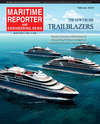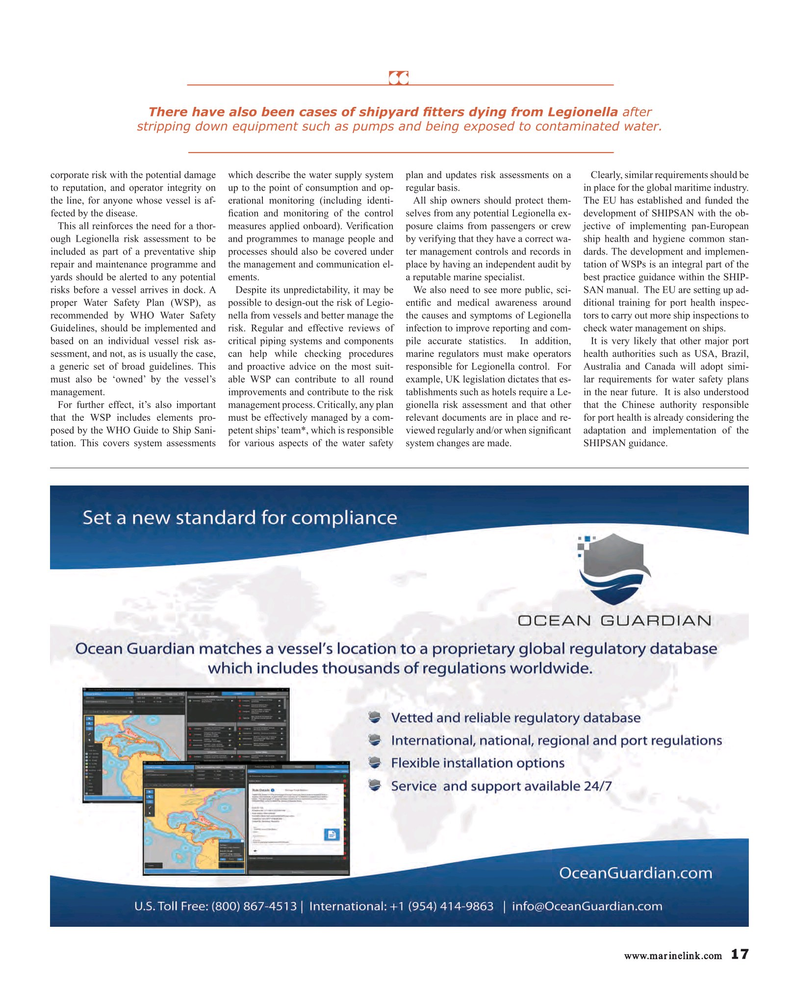
Page 17: of Maritime Reporter Magazine (February 2018)
Cruise Ship Annual
Read this page in Pdf, Flash or Html5 edition of February 2018 Maritime Reporter Magazine
“
There have also been cases of shipyard ? tters dying from Legionella after stripping down equipment such as pumps and being exposed to contaminated water.
corporate risk with the potential damage which describe the water supply system plan and updates risk assessments on a Clearly, similar requirements should be to reputation, and operator integrity on up to the point of consumption and op- regular basis. in place for the global maritime industry. the line, for anyone whose vessel is af- erational monitoring (including identi- All ship owners should protect them- The EU has established and funded the fected by the disease. ? cation and monitoring of the control selves from any potential Legionella ex- development of SHIPSAN with the ob-
This all reinforces the need for a thor- measures applied onboard). Veri? cation posure claims from passengers or crew jective of implementing pan-European ough Legionella risk assessment to be and programmes to manage people and by verifying that they have a correct wa- ship health and hygiene common stan- included as part of a preventative ship processes should also be covered under ter management controls and records in dards. The development and implemen- repair and maintenance programme and the management and communication el- place by having an independent audit by tation of WSPs is an integral part of the yards should be alerted to any potential ements. a reputable marine specialist. best practice guidance within the SHIP- risks before a vessel arrives in dock. A Despite its unpredictability, it may be We also need to see more public, sci- SAN manual. The EU are setting up ad- proper Water Safety Plan (WSP), as possible to design-out the risk of Legio- enti? c and medical awareness around ditional training for port health inspec- recommended by WHO Water Safety nella from vessels and better manage the the causes and symptoms of Legionella tors to carry out more ship inspections to
Guidelines, should be implemented and risk. Regular and effective reviews of infection to improve reporting and com- check water management on ships.
based on an individual vessel risk as- critical piping systems and components pile accurate statistics. In addition, It is very likely that other major port sessment, and not, as is usually the case, can help while checking procedures marine regulators must make operators health authorities such as USA, Brazil, a generic set of broad guidelines. This and proactive advice on the most suit- responsible for Legionella control. For Australia and Canada will adopt simi- must also be ‘owned’ by the vessel’s able WSP can contribute to all round example, UK legislation dictates that es- lar requirements for water safety plans management. improvements and contribute to the risk tablishments such as hotels require a Le- in the near future. It is also understood
For further effect, it’s also important management process. Critically, any plan gionella risk assessment and that other that the Chinese authority responsible that the WSP includes elements pro- must be effectively managed by a com- relevant documents are in place and re- for port health is already considering the posed by the WHO Guide to Ship Sani- petent ships’ team*, which is responsible viewed regularly and/or when signi? cant adaptation and implementation of the tation. This covers system assessments for various aspects of the water safety system changes are made. SHIPSAN guidance. www.marinelink.com 17
MR #2 (10-17).indd 17 MR #2 (10-17).indd 17 2/8/2018 9:47:38 AM2/8/2018 9:47:38 AM

 16
16

 18
18
